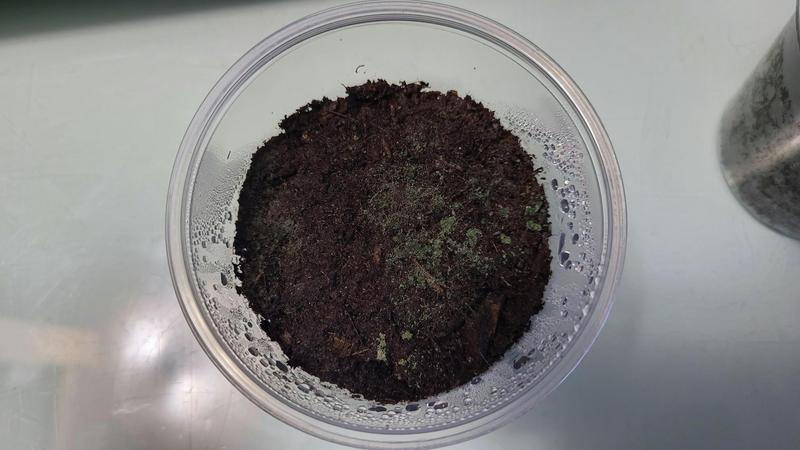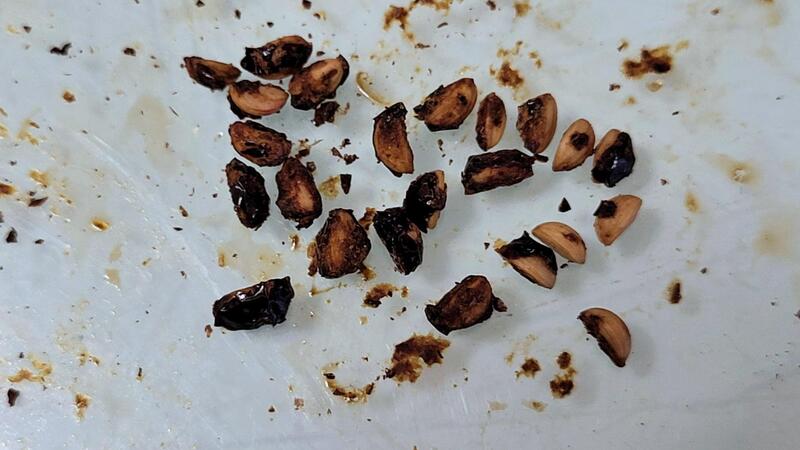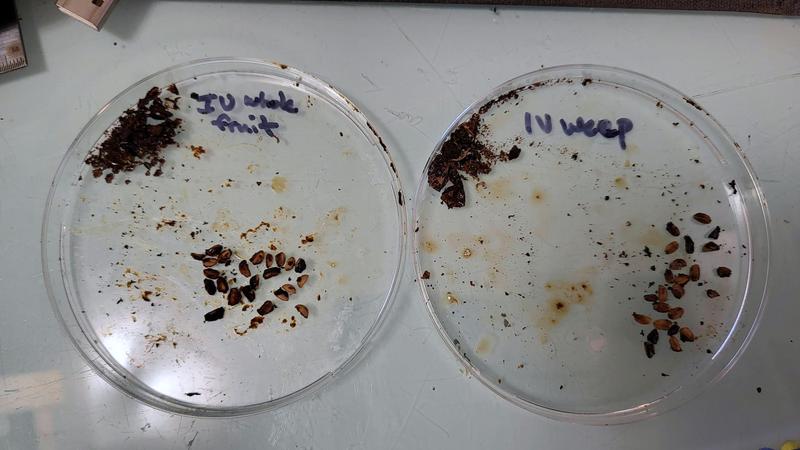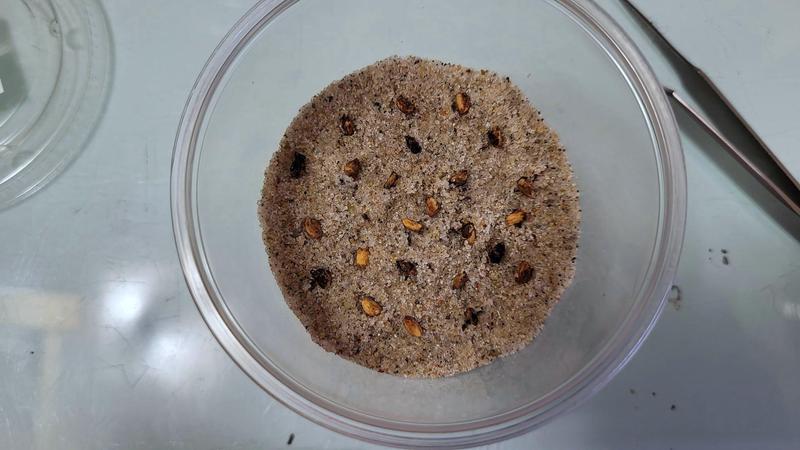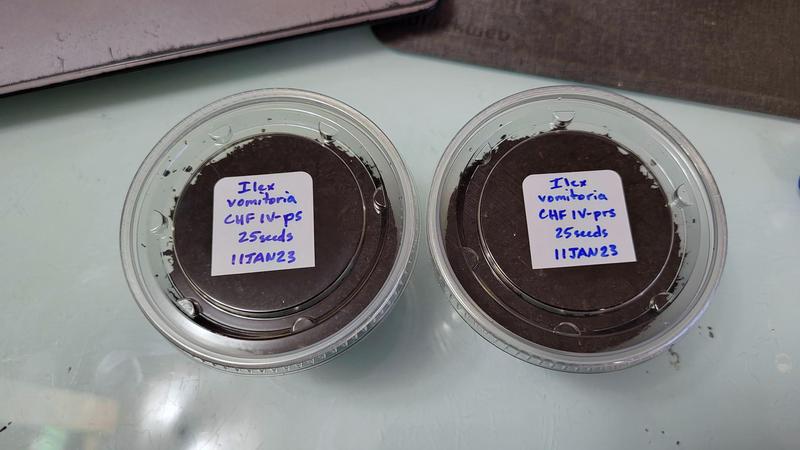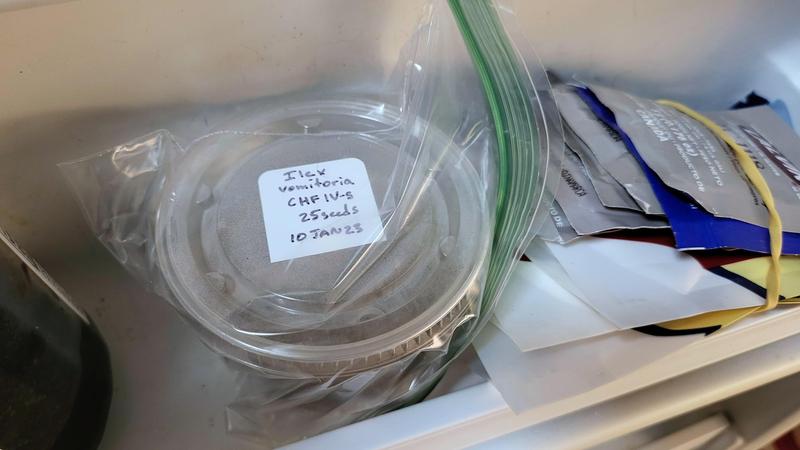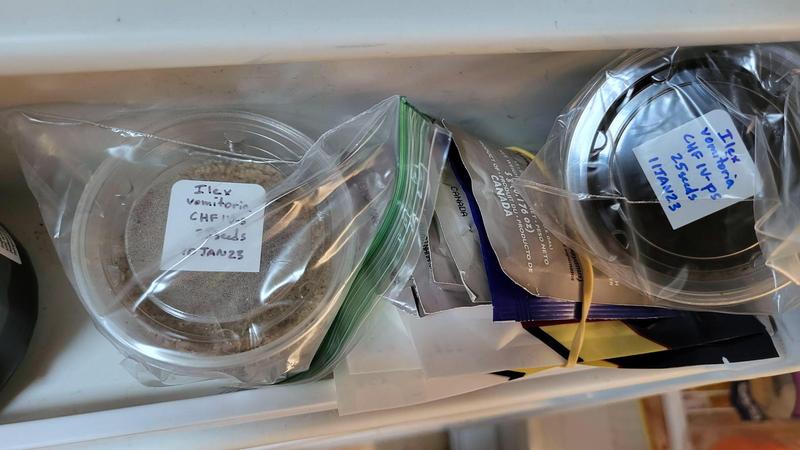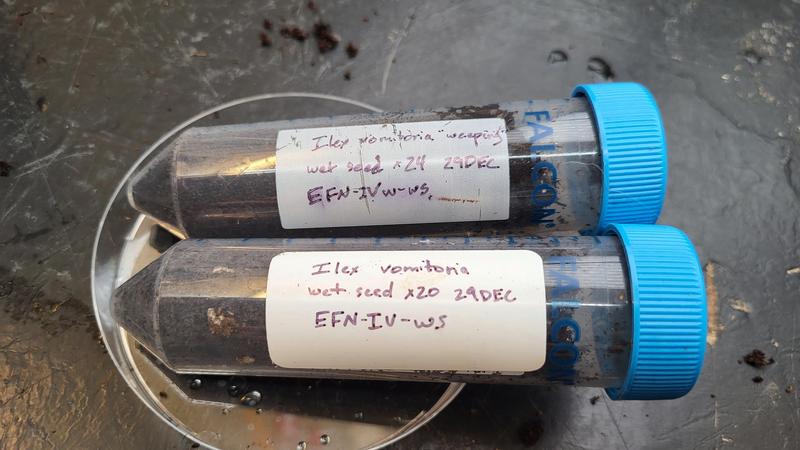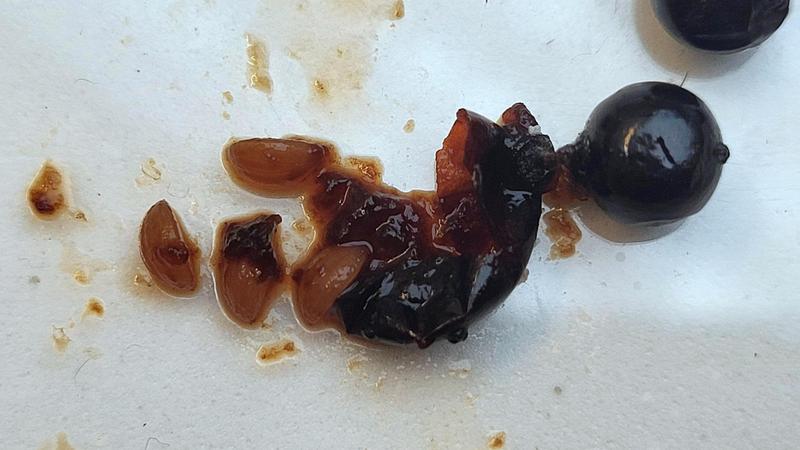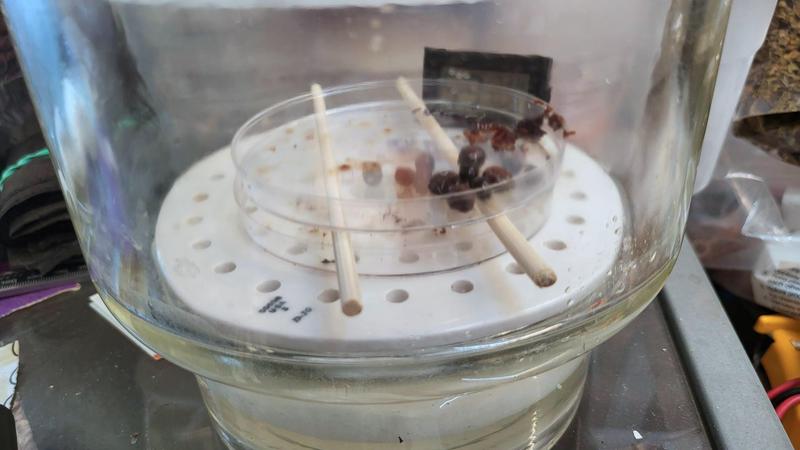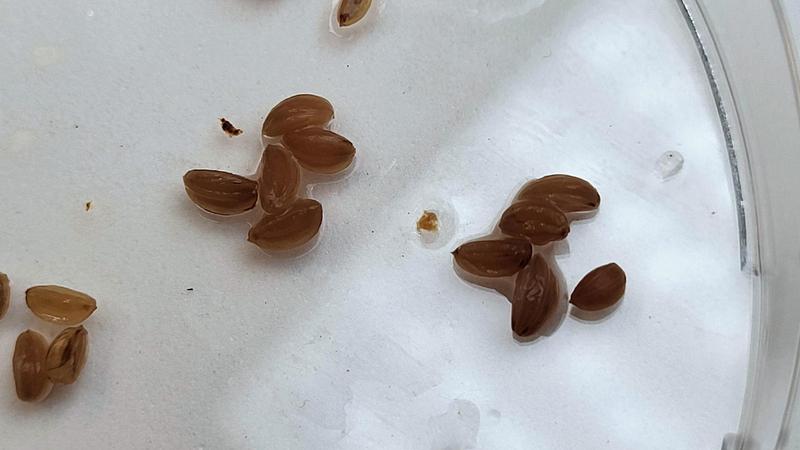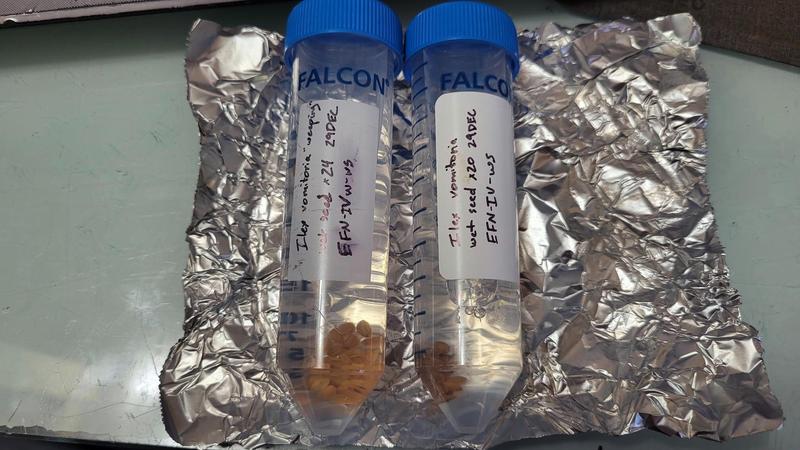Ilex vomitoria
One of only two native North American plant to produce caffeine. Does not cause vomiting.
Propagation
Germination
| media | germination | temperature °C | note | reference |
|---|---|---|---|---|
There is no established protocol for germination testing of Ilex spp. (2008).[1]
Ilex aquifolium, I. glabra, I. montana, I. opaca, I. cassine, and I. vomitoria are native to the temperature regions of North America. Germination procedures from these closely related species are the most useful to fill the gap of specifics for vomitoria. The more popular I. paraguarensis (yerba maté) and other South American native species are less useful for predicting germination conditions for I. vomitora.[2]
The growth of excised embryos of aquifolium and opaca were dose-dependently inhibited by light. Similarly, growth was dose-dependently suppressed by a high concentration of GA3 in light but didn’t significantly affect growth in dark incubation trials.[3]
In contrast, earlier research shows that excised embryos of eleven Ilex spp., including aquifolium and opaca, showed no abnormal growth or reduced germination with light incubation. However, seedlings cultured in darkness showed morphological deficiencies: etiolation, stunting, etc..[4]
[5] [6] [7] [2] [8] [9] [1] [10] [11] [12] [13]
Vegetative
In-Vitro
| basal media | supplements | source | target | note | reference |
|---|---|---|---|---|---|
Cultivation
| Planting density (m-2) | inter-row space (cm) | intra-row space (cm) | note | reference |
|---|---|---|---|---|
Harvest
Yield
| product | source | yield per season (kg/ha) | note | reference |
|---|---|---|---|---|
| product | source | yield per plant | note | reference |
|---|---|---|---|---|
Soilless
Soil
| soil type | pH | C-content % | precipitation | temperature (°C) | altitude (m) | note | reference |
|---|---|---|---|---|---|---|---|
Fertilization
| type | rate | time | note | reference |
|---|---|---|---|---|
Temperature
Lighting
| fixture type | photoperiod | illumination | note | reference |
|---|---|---|---|---|
Pests
Ecology
Morphology
| character | measurement | unit | notes | reference |
|---|---|---|---|---|
| seed weight | 83,350 | /kg | review | [1] |
Roots
Stem
Leaves
Inflorescence
Seeds
Phytochemistry
| compound | source | concentration (mg/g dry weight) | note | reference |
|---|---|---|---|---|
Infraspecific Variation
Biosynthesis
Distribution
Timecourse
Improvement
| trait | improvement status | reference |
|---|---|---|
The minimum seed-bearing age is 4-7 years.[1]
Identification
| variety | description | reference |
|---|---|---|
Inheritance
Methods
| type | note | reference |
|---|---|---|
History & Society
Work Log
15 Mar 2023
Combined the transfers into one group so it is easier.
Moved EFN-IV-df, CHF IV-ps, EFN-IV-df, CHF IV-s, EFN-IVw-df to the refrigerator. Moved CHF-IV-prs, CHF-IV-rs, EFN-IVw-ws, EFN-IV-ws to incubator
18 Feb 2023
Moved EFN dried fruit seeds to the incubator. Moved EFN wet seed in peat to the refrigerator.
12 Feb 2023
Switched CHF IV seeds between refrigerator and incubator conditions (a couple of days late).
26 Jan 2023
An example of the mold growing on the peat-based substrate tests.
21 Jan 2023
The desiccated fruits have been processed. They are very messy and difficult to work with. Desiccation after removal from the fruit is way better.
Yield 24 seeds from each weeping and regular vomitoria type.
I have elected to use only sand for these tests. The peat cups have already shown significant molding.
So as of this moment, I have these groups:
| id | variety | origin | count | media | protocol | note |
|---|---|---|---|---|---|---|
| EFN-IVw-df | weeping | EFN | 24 | sand | fridge -> incubator -> fridge -> … | dried fruit; split into two cups: 18/6 seeds |
| EFN-IV-df | regular | EFN | 24 | sand | fridge -> incubator -> fridge -> … | dried fruit |
| EFN-IV-ws | regular | EFN | 24 | peat | leach -> incubator -> fridge -> … | wet seed |
| EFN-IVw-ws | weeping | EFN | 20 | peat | leach -> incubator -> fridge -> … | wet seed |
| CHF-IV-rs | regular | CHF | 25 | sand | incubator -> fridge -> … | |
| CHF-IV-s | regular | CHF | 25 | sand | fridge -> incubator -> … | |
| CHF-IV-prs | regular | CHF | 25 | peat | incubator -> fridge -> … | |
| CHF-IV-ps | regular | CHF | 25 | peat | fridge -> incubator -> … |
The treatments are incubator/refrigerator first, dried-in-fruit/sown wet, and sown in peat/sand. I have two sources (CHF and EFN) and two varieties (regular and weeping from EFN). Some of the seeds were also soaked in water for 24 hours but I forgot that step with the rest of the tests.
As with basically all of my tests, the sample sizes are incredibly low and only serve as exploratory research.
10 Jan 2023
Set 25 of each seed group into sterilized sand and peat in 3oz clear cups. One will go into the fridge. The other into the germination chamber.
I also moved seeds from falcon tubes to 3oz cups. I didn’t like the poor distribution in those tubes. Now everything is in the same cups.
31 Dec 2022
Decanted wet seeds and put into sterilized damp peat moss in 50 ml tubes. Tubes were shaken to distribute seeds.
29 Dec 2022
Dissecting the vomitoria fruit from EFN. 11 fruit were received. 4 seeds per fruit.
Half of the fruits will be dried whole.
The other half will be kept wet.
I also want to test two variations: warm incubation first or cold. The 110 seeds from CH will be split into 4 groups of 25 plus 10 left for in-vitro tests later.
28 Dec 2022
Seeds from CH received.
27 Dec 2022
Seeds from EFN received. Two varieties: regular and “weeping”. These seeds are still in the fruit and have not been dried.
Bibliography
- F. T. Bonner and R. P. Karrfalt, “The Woody Plant Seed Manual,” Agric. Handbook No. 727. Washington, DC. U.S. Department of Agriculture, Forest Service. 1223 p., vol. 727, 2008.
https://www.srs.fs.usda.gov/pubs/32626.
Publication from the USDA Forest Service Southern Research Station
- G. Galíndez et al., “Three Levels of Simple Morphophysiological Dormancy in Seeds of Ilex (Aquifoliaceae) Species from Argentina,” Seed Science Research, vol. 28, no. 2, pp. 131–139, Jun. 2018.
doi: 10.1017/S0960258518000132.
As a contribution to understanding the world biogeography of seed dormancy in the cosmopolitan genus Ilex, we studied seeds of I. argentina, I. brasiliensis, I. brevicuspis, I. dumosa, I. paraguariensis and I. theezans from the subtropical region of Argentina. We hypothesized that seeds of these species have non-deep simple morphophysiological dormancy (MPD). Effects of temperature, cold stratification and gibberellic acid (GA3) on seed germination and embryo growth were tested. Regardless of incubation temperature, little or no germination occurred for any species until ≥6 weeks. There was an up to 3-fold increase in embryo length to seed length (E:S) ratio before seeds germinated, and embryos grew only during warm-stratifying conditions. Seeds of I. brasiliensis, I. brevicuspis and I. theezans had non-deep simple MPD and germinated to ≥80% after 12, 24 and 16 weeks, respectively. Cold stratification increased germination of I. brasiliensis and I. brevicuspis, and GA3 increased the rate but not final germination percentage of I. brasiliensis and I. theezans. Fresh seeds of I. dumosa required 40 weeks of warm stratification to germinate to 53%, while those after-ripened for 2 months germinated to 81% after 30 weeks; this species has intermediate simple MPD. Seeds of I. argentina and I. paraguariensis germinated to 15 and 21%, respectively, after 40 weeks of warm stratification and did not after-ripen or respond to GA3; these seeds have deep simple MPD. This is the first report of intermediate and deep simple MPD that is broken by warm stratification, thereby increasing our knowledge of seed dormancy in Ilex and in subtropical regions.
- A. G. Ferreira and C.-yeh Hu, “Light-Mediated Inhibition of in Vitro Late Embryogeny of Ilex,” Journal of the American Society for Horticultural Science, vol. 114, no. 5, pp. 819–823, Sep. 1989.
doi: 10.21273/JASHS.114.5.819.
Abstract An inhibitory effect of light on in vitro late embyogeny of I. aquifolium and I. opaca cv. Farage was observed. A negative log-linear correlation between the final embryo size and hours of continuous light during preincubation, at an intensity of 64 W·m−2, was established with I. aquifolium. It took ≈ 15 hr of pre-incubation light to result in 50% growth inhibition. Negative log-linear correlations between the final embryo lengths and light intensities were also observed for I. aquifolium and I. opaca. The rudimentary embryos of I. opaca were more sensitive to light inhibition than those of I. aquifolium. During incubation for 11 and 14 days with a 16-hr photoperiod, light intensities for 50% growth inhibition were ≈ 5 and 11 W·m−2 for I. opaca and I. aquifolium, respectively. Since growth inhibition by light could not be reversed by the presence of GA3 concentrations up to 1000 μm, some factor(s) other than the accumulation of abscisic acid or related compounds is probably responsible for such a phenomenon.
- C. Y. Hu, “In Vitro Culture of Rudimentary Embryos of Eleven Ilex Species,” Journal of the American Society for Horticultural Science, vol. 100, no. 3, pp. 221–225, May 1975.
doi: 10.21273/JASHS.100.3.221.
Abstract The heart-shaped embryos, dissected from mature fruits of 11 Ilex (holly) species in 4 taxonomic sections, grown in modified White’s and Linsmaier and Skoog’s media jelled with Bacto-agar, produced seedlings. The rudimentary embryos were sufficiently autotrophic that a carbon source was the only organic compound needed in the media. There is a great variation in speed of in vitro development among individual embryos of the same species. The average embryo length of I. aquifolium L. increased linearly and most embryos reached germination size at the 55th day of incubation. The average embryo length of I. cornuta Lindl. increased sigmoidally and most embryos reached germination size at the 23rd day of incubation. The in vitro germination percentages for most species were above 80%. The survival rates after transplanting were higher than 75%. Sub-sequent seedling growth in greenhouses was healthy and vigorous.
- C. S. (C. S. Schopmeyer, United States, and Forest Service, “Seeds of Woody Plants in the United States,” pp. viii, 883 , [8] leaves of plates : ill. (some col.) ; 27 cm.-USDA, 1974. https://handle.nal.usda.gov/10113/CAT30962875.
- J. S. Meadows, F. T. Bonner, and J. D. Haywood, “Soil-Seed Bank Survival in Forests of the Southern United States,” New Forests, vol. 32, no. 3, pp. 335–345, Nov. 2006.
doi: 10.1007/s11056-006-9007-6.
We evaluated the longevity of seeds of 12 common woody species buried in fresh condition in the forest floor at three forest locations in Mississippi and Louisiana. Seed samples of each species were retrieved annually for 5 years from each location. Germination and tetrazolium chloride staining tests were conducted on the samples to determine germinative capacity. When averaged across all species, seeds remained viable longer at the Alexandria, Louisiana site than at the two sites in Mississippi. Seeds of the 12 species varied widely in their response to burial. Some species, such as American beautyberry (Callicarpa americana L.), muscadine grape (Vitis rotundifolia Michx.), and sugarberry (Celtis laevigata Willd.), had relatively high germinative capacities (from 33 to 60 percent, depending on species) even after burial in the forest floor for 5 years, whereas other species, such as flowering dogwood (Cornus florida L.) and yaupon (Ilex vomitoria Ait.), had very low germinative capacities (less than 6 percent) by the end of the first year after burial. Species were classified into five groups based on their similarity of response.
- N. R. Dolce, R. D. Medina, L. A. Mroginski, and H. Y. Rey, “Sowing Pyrenes under Aseptic Conditions Enhances Seed Germination of Ilex Brasi Liensis, I. Pseudoboxus and I. Theezans (Aquifoliaceae),” Seed Science and Technology, vol. 43, no. 2, pp. 273–277, Aug. 2015.
doi: 10.15258/sst.2015.43.2.04.
Seeds of Ilex species are individually enclosed by a woody endocarp, forming a dispersal unit termed a pyrene. Embryos are undeveloped when fruits reach maturity. As a consequence, germination is low even after several months under proper conditions. In the present study, we present reliable and reproducible techniques that enhance seed germination of Ilex brasiliensis, I. pseudoboxus and I. theezans by aseptically sowing whole pyrenes. The highest germination percentages (53-92%) were reached by in vitro culturing whole pyrenes on solidified (0.65% agar) quarter-strength Murashige and Skoog medium with 3% sucrose and 0.1 mg l-1 zeatin, and incubating in a growth room at 27 ± 2°C with a 14-hour photoperiod. Thus, the in vitro culture of whole pyrenes constitutes an easy and efficient technique to obtain quick germination of these Ilex species and may be an alternative to embryo rescue. Rapid progress in the application of this method to breeding and preservation programmes of Ilex species is expected.
- C. M. Fleming, “Germination of Yaupon (Ilex Vomitoria Ait.) Seed,” Thesis, Texas A&M University, 1970.
https://oaktrust.library.tamu.edu/handle/1969.1/ETD-TAMU-1970-THESIS-F597.
Not available
- E. R. Jensen, “A Study of the Development Morphology and the Physiology of Dormancy in Seed of Yaupon Holly (Ilek Vomitoria Ait.) - ProQuest,” PhD thesis, Texas A&M, 1955.
https://www.proquest.com/openview/b8cd763f692062556277ccb91377437e/1?pq-origsite=gscholar&cbl=18750&diss=y.
Explore millions of resources from scholarly journals, books, newspapers, videos and more, on the ProQuest Platform.
- C.-Y. Hu, F. Rogalski, and C. Ward, “Factors Maintaining Ilex Rudimentary Embryos in the Quiescent State and the Ultrastructural Changes during In Vitro Activation,” Botanical Gazette, vol. 140, no. 3, pp. 272–279, Sep. 1979.
doi: 10.1086/337085.
The rudimentary embryos in mature seeds of eight species of Ilex were in a state of quiescence, or growth arrest, rather than a state of extremely slow growth. Ultrastructure of the quiescent embryo showed that the storage material, lipid and protein bodies, accounted for more than 80% of the cellular volume with a few unidentified, membrane-bound spherical bodies located in a thin layer of cytoplasm about the periphery of the nucleus. Other organelles were either scarce or absent. In vitro culture of excised rudimentary embryos resulted in immediate resumption of embryonic growth. Both glucose and non-reducing sugars (sucrose, raffinose, and stachyose) in the culture medium supported embryonic growth, while the presence of Ilex endosperm tissue in culture inhibited such growth. Since these are the major sugars of Ilex endosperm, the embryo culture experiments suggest that an inhibitor in the endosperm is likely to be responsible for the maintenance of embryo quiescence in the seed. Lipid and protein bodies disappeared in in vitro-activated rudimentary embryos. Starch grains became the principal storage material. Vacuoles, mitochondria, dictyosomes, polysomes, rough endoplasmic reticulum, microtubules, and other membrane-bound spherical bodies were prominent. The ultrastructure of the quiescent rudimentary embryo and the changes accompanying the activation of the embryo closely resemble those of quiescent mature embryos and the initial germination changes in embryos of other plants.
- N. R. Dolce, L. A. Mroginski, and H. Y. Rey, “Endosperm and Endocarp Effects on the Ilex Paraguariensis A. St.-Hil. (Aquifoliaceae) Seed Germination,” Seed Science and Technology, vol. 38, no. 2, pp. 441–448, Jul. 2010.
doi: 10.15258/sst.2010.38.2.17.
To develop a procedure for regenerating plants directly from pyrenes, as an alternative to in vitro embryo culture, germination studies were done on maté tree, Ilex paraguariensis, seeds using aseptic conditions. The effect of the endosperm, the woody endocarp and cold treatment on embryo development and germination were examined by culturing isolated embryos, intact, acid-scarified and bisected pyrenes from mature fruits. The results show that maté tree plantlets may be obtained by in vitro culture of bisected pyrenes on solidified (0.65% agar) quarter-strength Murashige and Skoog medium containing 3% sucrose. It is recommended to pre-culture the pyrenes at 4 ± 2°C to obtain a higher germination rate and more vigorous seedlings. This is the first report of the in vitro culture of Ilex pyrenes. Compared to the culture of isolated embryos this procedure shortens the duration of the embryo culture technique and minimizes damage to the young embryos.
- A. C. de Souza et al., “Causes of Dormancy in Ilex Paraguariensis Pyrenes,” Rodriguésia, vol. 73, Apr. 2022.
doi: 10.1590/2175-7860202273036.
Abstract Ilex parguariensis pyrenes, popularly known as “yerba mate”, were classified as dormant. This study aim to investigated the causes of dormancy in Ilex paraguariensis’ pyrenes. Hence, the following tests were performed: a) Physical dormancy: rate of absorption in water and methylene blue; detection of lignin and lipophilic compounds in the endocarp and integument; b) Physiological dormancy: bioassays in lettuce seeds, detection, and quantification of phenolic compounds; c) Morphological dormancy: embryo analysis. For the absorption rate, an increase was observed in the mass of the pyrenes, however, when imbibition was performed in methylene blue, absorption only occurred in the endocarp. Lignin was also observed in the form of a sclerenchyma layer next to the seed coat. Similarly, lipophilic compounds were observed in a layer, external to the endosperm. The bioassays with lettuce seeds indicated the presence of chemical inhibitors. In the morphological evaluation of the pyrenes, only 55.5% of the embryos were visualized and they were in the globular or heart stages. Ilex paraguariensis pyrenes have combined dormancy: physical (not water absorption), morphological (due to the underdeveloped embryo), and there are shreds of evidence about physiological dormancy (presence of inhibitors); however, it is recommended to investigate the inhibitory agent.
- N. R. Dolce, L. A. Mroginski, and H. Y. Rey, “Enhanced Seed Germination of Ilex Dumosa R. (Aquifoliaceae) through In Vitro Culture of Cut Pyrenes,” HortScience, vol. 46, no. 2, pp. 278–281, Feb. 2011.
doi: 10.21273/HORTSCI.46.2.278.
An in vitro culture protocol was developed that increased the germination percentage and decreased the lag time to germination for Ilex dumosa R. pyrenes as a tool for replacing the laborious task of embryo rescue technique. This method involves transversely cutting surface-sterilized pyrenes with a scalpel blade, then placing the micropylar one-third end with the rudimentary embryo (≈0.25 mm long) on solidified (agar 0.65%) quarter-strength salts and vitamins of medium with 3% sucrose, and incubating in a growth room at 27 ± 2 °C with a 14-h photoperiod (116 μmol·m−2·s−1). Most of the cut pyrenes (greater than 50%) germinated within the first month after inoculation and achieved maximum germination (≈70%) in 2 months compared with whole pyrenes, which began to germinate 3 months after sowing and required more than 8 months for maximum germination (37%). Moreover, the germination percentage of cut pyrenes was significantly higher than the germination of isolated embryos (34%). Thus, the cut pyrenes culture is a simpler and more effective technique than embryo rescue. Easily, on average, a trained operator is able to culture ≈1000 cut pyrenes per day instead of ≈100 isolated embryos.
- I. Wendling, G. E. Brondani, A. de Biassio, and L. F. Dutra, “Vegetative Propagation of Adult Ilex Paraguariensis Trees through Epicormic Shoots,” Acta Scientiarum. Agronomy, vol. 35, pp. 117–125, Mar. 2013.
doi: 10.4025/actasciagron.v35i1.15958.
The difficulty and length of time required for seed germination of mate (Ilex paraguariensis), as well as the pressing need for clonal multiplication of improved genetic material, has resulted in several studies related to vegetative propagation in an effort to obtain rooted cuttings more quickly and with better genetic quality. Currently, the biggest challenge is propagating and rooting adult plants selected in the field without requiring clear cutting to generate conditions for the basal induction of juvenile sprouts. Therefore, the objective of this study was to develop a method to rescue adult mate plants through the generation of epicormic sprouts. To accomplish this, tree branches of mate that were at least 19 years of age were collected and packed in trays with sand for sprouting. Different solutions containing a mixture of sucrose and indole-3-butyric acid (IBA) were sprayed in branches at 29, 22, 15, 8 and 1 day(s) before collection. We conclude that the vegetative propagation of adult mate trees is technically efficient and requires no treatment with sucrose or IBA and results in the formation of plants suitable for planting or serving as mother plants for continuous multiplication via cloning.
- C. R. Lambert, F. A. Blazich, and A. V. LeBude, “Propagation of Ilex Vomitoria ‘Dare County’ by Stem Cuttings,” Journal of Environmental Horticulture, vol. 30, no. 2, pp. 55–57, Jun. 2012.
doi: 10.24266/0738-2898.30.2.55.
Semi-hardwood or hardwood stem cuttings of Ilex vomitoria Sol. ex Ait. ‘Dare County’ [‘Dare County’ yaupon holly (syn. ‘Virginia Dare’ yaupon holly)] were treated with solutions of the potassium (K) salt (K-salt) of indolebutyric acid (K-IBA) at 0 to 8000 mg liter−1 (ppm). Nontreated semi-hardwood cuttings rooted at 78% whereas, regardless of auxin treatment, hardwood cuttings taken on two dates rooted at 15%. Treatment of cuttings with K-IBA was generally ineffective and resulted in a linear decrease (P ≤ 0.05) in percent rooting of semi-hardwood cuttings.
- J. Adelberg, C. Tanner, R. El-hawaz, and N. Tharayil, “Shade and Fertilizer Affects Yield and Quality in a Clonal Plantation of Yaupon Holly,” 2021.
doi: 10.7275/985V-NW12.
Yaupon holly (Ilex vomitoria Ait.) is the only native American source of caffeinated tea and the small amounts of tea product that is available is currently wild-collected from diverse populations. A clonal field plantation of yaupon was grown under shading and fertilizer treatments and harvested three times in one season to observe changes in yield and phytochemistry. The June and September harvest produced more mass than the July harvest for all treatments. Shading and fertility had interactive effects on increasing fresh mass of the pooled annual harvest, whereas the providing 30% shade and increased fertilizer application (from 567 to 1163 mg/N plant) raised yield 58%. Fertility of 1163 mg/N per plant with 60% shade increased yield another 13% to approximately 1070 kg/ha. This experimental plantation contained 467 plants per ha and was at about half the density of commercial fields (882 plants per ha). Leaves were smaller in July and larger in June and September. Shade greatly increased the leaf size and water content. Caffeine content increased with leaf size over the duration of the experimental treatments and 60% shade treatments in September produced the highest caffeine content (1.21 ± 0.17% of dry mass). In general alkaloids were promoted by shading, and phenylpropanoids were promoted by bright light. This report from one season of observation showed that genetically uniform yaupon holly plantations were manipulated for yield and quality using shade and fertilizer.
